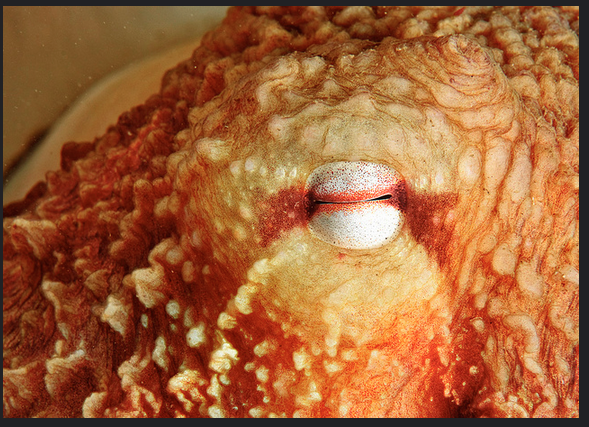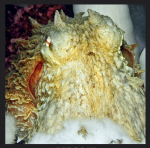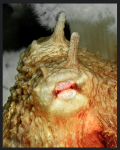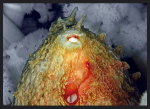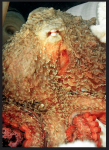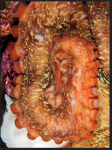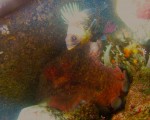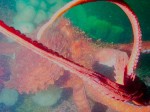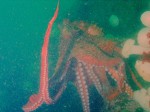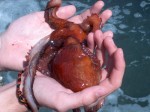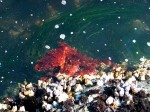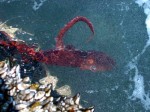Getting up close and personal was one of the things that former Ecoguardian Ryan Murphy was able to do very well underwater.. Consequently he produced the following interesting images from underwater.
We frequently encounter Octopus while diving at Race Rocks. They blend in very well with the algae and can change colors rapidly. Often the best way to see them is to spot their large (1-2 cm) white suckers in a crevice or cave. According to the website below, “Although it is very unusual to find an individual over 45kg, one large individual captured just near Victoria in 1967 weighed 70 kilograms (156 pounds) and was almost 7.5 meters ( 23 feet ) from arm tip to arm tip.
Smaller animals occur occasionally in low intertidal pools on rocky shores, larger individuals generally subtidal to depths of 100m; along North Pacific rim from northern Asia to California;
One of the largest octopus species known, the largest specimen on record with a total arm spread of 9.6m and a weight of 272 kg; dorsal mantle length usually over 20 cm; weight sometimes exceeding 50 kg; body ovoid, with extensive skin folds, red to reddish brown above, pale below; ocelli absent; arms 3-5 times body length, lacking specialized enlarged suckers and large truncate papillae; hectocotylus large, about one-fifth the length of the third right arm; with 12-15 lamellae on the outer demibranch of each gill; gill lamellae 25-29; ink dark brown; eggs measuring 6-8 mm by 2-3 mm, planktonic larva with a single row of chromatophores on each arm; borne in capsules on long stalks, these entangled and cemented together to form long festoons.
- Kohei and Nathan encountered this octopus while diving at Race Rocks. A rockfish looks on.
- Octopus photo by Kohei,April of 2007.
- A disturbed Octopus usually takes off quickly once it realizes its camouflage cover does not work.
The Giant Pacific Octopus, (Enteroctopus dofleini , Hochberg, 1998) was formerly classified as : Octopus dofleini (Wulker, 1910)
Giant Pacific Octopus frequently appear at Race Rocks in the subtidal waters. They are also seen occasionally washed up in the intertidal zone where they contribute to the energy flow of the gulls and eagles. This individual which had died recently in June 2002, became the subject of a webcast and an impromptu dissection on the shore.
Video on Octopus necropsy
Domain: Eukarya
Kingdom: Animalia
Phylum: Mollusca
Class: Cephalopoda
Order Octopoda
Suborder: Incirrata
Family :Octopodidae
Genus: Enteroctopus
Species: dofleini (Hochberg, 1998)
Common Name: Giant Pacific Octopus
Although E.dofleini has been used extensively in laboratory studies, its natural history is still poorly known. The life cycle is thought to be 4-5 years. Eggs are laid throughout the year, though mainly in the winter, and development takes 5-7 months; hatching peaks in the early spring. The young are pelagic for a short period, probably about 1 month.
- Baby octopus near the docks
- Photos by Ryan Murphy
The three images above of a baby Octopus were taken in the intertidal zone near the docks by
Ryan Murphy in July 2004.
The adults feed on crustaceans (shrimps and crabs), mollusks (scallops, clams, abalones, moon snails, and small octopuses, and fishes ( rockfishes, flat fishes, and sculpins). Large crabs are stalked and then caught with a sudden flick of one or more arms; empty crab carapaces, shiny shells, and bones often litter the entrance to a lair. The octopus takes smaller shrimps and fishes by slowly arching its body over a seaweed bed, then suddenly pouncing, and enclosing the area in a canopy formed by the web membrane that joins the basal parts of adjacent arms. The sensitive arm tips are then inserted into the impounded area to search for food.
- Two mesozoan parasites charactersictically occur in the kidneys of E. dofleini: Dicyemennea abreida and Conocyema deca.
This octopus is fed upon by seals, sea otters, dogfish sharks, lingcod, and man. It supports small commercial fisheries in Alaska, Canada, Washington, Oregon, and Northern California. Locally, it is also used by halibut fishers as bait.
Literature Cited:
Robert H. Morris, Donald P. Abbott, and Eugene C. Haderlie, Intertidal Invertebrates of California
Eugene N. Kozloff, Marine Invertebrates of the Pacific Northwest
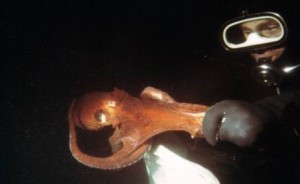 Link to an assignment on Biodiversity submitted to us by
Link to an assignment on Biodiversity submitted to us by
Shawna Millard Biology 202 at Bellevue Community College, Washington.
Return to the Race Rocks Taxonomy
This file is provided as part of a collaborative effort by the students, faculty and volunteers of Lester B. Pearson College . This file was started by: Amanda Muscat PC yr 27, Dec. 2001.

